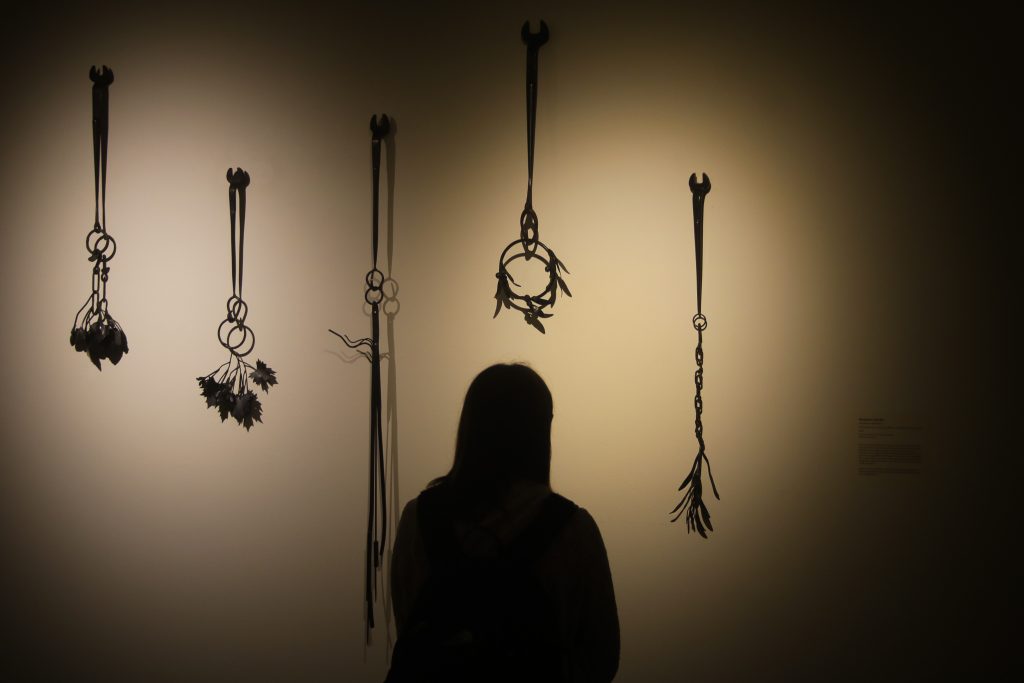The Binghamton University Art Museum’s newest exhibition unites generations of Haudenosaunee artists to share their historical relationship and reciprocity to the land across New York state.
Hosted this past Thursday, from 5 p.m. to 7 p.m., the exhibition’s opening reception featured remarks by Anthony Gonyea, a faithkeeper for the Onondaga Nation, and Luanne Redeye, 39, of Berkeley, California, a guest curator of the exhibition and an assistant professor of art practice at the University of California, Redeye taught at BU in the art and design department from 2019-2023.
“Homelands: Contemporary Haudenosaunee Art Across New York” focuses on Haudenosaunee artwork and practices and brings artists together to convey their connection to the land. The exhibition and the works featured are a visual form of knowledge-sharing and an invitation to reconnect with historically Indigenous land through mediums like photography, beadwork designs and documentary.
While Redeye, an enrolled member of the Seneca Nation of Indians and Hawk Clan, has exhibited her artwork in various galleries and exhibitions, this was their first curating experience. Similar to the themes explored in Redeye’s own work, her goal for this exhibition was to shed light on Indigenous culture and experiences.
“The Homelands exhibition began with a conversation with Claire Kovacs, the previous BUAM Curator,” Redeye wrote in an email. “I approached her after considering what actions I could take as faculty to bring forward Native voices and representation on the Binghamton campus. Claire was immediately on board with an exhibition showcasing Haudenosaunee artwork.”
The exhibition displays artwork made with or representing materials from the surrounding area, such as baskets made from black ash trees and paintings honoring the Three Sisters — corn, beans and squash — which are significant aspects of the Haudenosaunee Creation Story.
“Organic materials, such as clay, bark, and quills, are culturally tied, bringing forward a connection to the landscape,” Redeye wrote. “Clay is unique for its ability to record time and culture because there is memory in the land, imprints of people and communities. It’s those imprints that I was thinking about throughout the exhibition’s curation.”
At the gallery’s center is an enlarged photograph of a woman in Seneca-style attire standing in a cornfield. This piece, a part of Hayden Haynes’ photo series “The Spirit of the Corn,” is surrounded by a corn installation that occupies floor space, asserting Native presence on ancestrally Indigenous land. The corn also represents the harvest, typically led by Haudenosaunee women and is a gathering of teaching and storytelling.
While Haynes, 41, of the Seneca Nation of Indians Deer Clan who works from the Seneca-Allegany territory in western New York, has been doing photography for five years, his main art practice is antler carvings — also displayed in the exhibition. His work with antlers is a part of his goal as an artist to revive and celebrate traditional Haudenosaunee practices.
“Sometimes it can be historical ideas,” Haynes said. “Because there’s not a lot of antler carvers out there anymore that are Haudenosaunee. Part of my goal is to revive antler carving again, because it’s an ancient practice that our ancestors did … My goal is to show it so that it might inspire somebody to take up the art form too.”
Gonyea, a maker of Haudenosaunee wampum belt replicas and a wood and stone carver, also had works featured in the exhibition. Wampum belts serve as a vital part of Haudenosaunee culture, serving as invitations to other nations for council meetings and as records of important events.
This semester’s main gallery exhibition not only highlights the collaboration between museum field professionals and Haudenosaunee artists but also the need to keep Indigenous voices and culture represented further away from their territories. Redeye shared the significance of cultivating Indigenous expression.
“The exhibition is important because it brings forward the voices, perspectives, and talent of Haudenosaunee artists,” Redeye wrote. “It’s also an opportunity for Native students on campus and native folks in the Binghamton community to feel seen and reflected in the work. Speaking to Contemporary Art in general, it is rare for Native folks to enter a space and feel held by the work.”
“Homelands: Contemporary Haudenosaunee Art Across New York” will be on display from Sept. 5 to Dec. 7.



